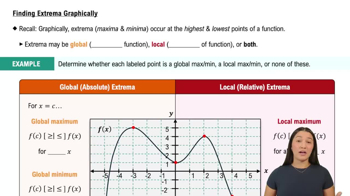Table of contents
- 0. Functions7h 52m
- Introduction to Functions16m
- Piecewise Functions10m
- Properties of Functions9m
- Common Functions1h 8m
- Transformations5m
- Combining Functions27m
- Exponent rules32m
- Exponential Functions28m
- Logarithmic Functions24m
- Properties of Logarithms34m
- Exponential & Logarithmic Equations35m
- Introduction to Trigonometric Functions38m
- Graphs of Trigonometric Functions44m
- Trigonometric Identities47m
- Inverse Trigonometric Functions48m
- 1. Limits and Continuity2h 2m
- 2. Intro to Derivatives1h 33m
- 3. Techniques of Differentiation3h 18m
- 4. Applications of Derivatives2h 38m
- 5. Graphical Applications of Derivatives6h 2m
- 6. Derivatives of Inverse, Exponential, & Logarithmic Functions2h 37m
- 7. Antiderivatives & Indefinite Integrals1h 26m
- 8. Definite Integrals4h 44m
- 9. Graphical Applications of Integrals2h 27m
- 10. Physics Applications of Integrals 2h 22m
5. Graphical Applications of Derivatives
Intro to Extrema
Problem 4.R.2b
Textbook Question
Locating extrema Consider the graph of a function ƒ on the interval [-3, 3]. <IMAGE>
b. Give the approximate coordinates of the absolute maximum and minimum values of ƒ (if they exist).
 Verified step by step guidance
Verified step by step guidance1
Begin by understanding the concept of extrema. Extrema refer to the maximum and minimum values of a function within a given interval. Absolute extrema are the highest and lowest points over the entire interval.
Examine the graph of the function ƒ on the interval [-3, 3]. Look for the highest point on the graph within this interval to identify the absolute maximum, and the lowest point to identify the absolute minimum.
Check the endpoints of the interval, x = -3 and x = 3, as extrema can occur at these points. Compare the function values at these endpoints with other points within the interval.
Identify any critical points within the interval [-3, 3]. Critical points occur where the derivative of the function is zero or undefined. These points can potentially be locations of extrema.
After identifying potential extrema points, compare their function values to determine which is the absolute maximum and which is the absolute minimum. Remember, the absolute maximum is the largest value, and the absolute minimum is the smallest value within the interval.
 Verified video answer for a similar problem:
Verified video answer for a similar problem:This video solution was recommended by our tutors as helpful for the problem above
Video duration:
2mPlay a video:
Was this helpful?
Key Concepts
Here are the essential concepts you must grasp in order to answer the question correctly.
Extrema
Extrema refer to the maximum and minimum values of a function within a given interval. An absolute maximum is the highest point on the graph over that interval, while an absolute minimum is the lowest point. Identifying these points is crucial for understanding the behavior of the function and can involve evaluating the function at critical points and endpoints.
Recommended video:

Finding Extrema Graphically
Critical Points
Critical points are values in the domain of a function where its derivative is either zero or undefined. These points are essential for locating extrema, as they indicate where the function may change direction. To find absolute extrema, one must evaluate the function at these critical points as well as at the endpoints of the interval.
Recommended video:

Critical Points
Closed Interval
A closed interval, denoted as [a, b], includes its endpoints a and b. In calculus, analyzing functions over closed intervals is important because it guarantees that the function will attain both maximum and minimum values within that range. This is a key aspect of the Extreme Value Theorem, which states that continuous functions on closed intervals achieve their extrema.
Recommended video:

Finding Global Extrema (Extreme Value Theorem)

 5:58m
5:58mWatch next
Master Finding Extrema Graphically with a bite sized video explanation from Callie
Start learning




